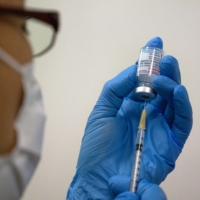The coronavirus vaccination rollout for people under 65 in Japan should be carried out at the same time as those with underlying conditions to help speed up the process, the health minister said Sunday.
While those with underlying conditions will generally be given priority, “if we wait until everyone (with underlying conditions) has been vaccinated, we don’t know when it will be completed,” Health, Labor and Welfare Minister Norihisa Tamura said on a program aired by public broadcaster NHK.
Those who qualify to receive priority vaccinations will need to report to municipalities independently, as the government has no data available as to exactly how many people are eligible.
Japan’s vaccination program was launched in February for health care workers and expanded to those 65 and older in April. The government planned to vaccinate those with underlying conditions next and finally the general public after it finished vaccinating the elderly by the end of July.
But the government is looking to speed up the country’s vaccine rollout, which has lagged behind other countries, with just 6% of its population having received at least one dose. With the medical system remaining strained, the COVID-19 state of emergency in Tokyo, Osaka and seven other prefectures was extended on Friday by three weeks to June 20.
Tamura said he wants local governments to prepare to administer vaccinations to those eligible under 65, prioritizing those with underlying conditions.
The central government is also considering administering U.S. pharmaceutical company Moderna Inc.’s vaccine, which was approved in Japan in May, at workplaces, to further accelerate the rollout, he said.
Large-scale COVID-19 vaccination centers run by Self-Defense Forces personnel will begin full-scale operations from Monday, a week after opening, raising the maximum number of inoculations per day to 10,000 in Tokyo and 5,000 in Osaka.
The centers, which currently target those 65 and older, are available to about 9 million people in the greater Tokyo metropolitan area and about 4.7 million people in the three western prefectures of Osaka, Kyoto and Hyogo.
The state of emergency, currently in place over the nine prefectures and Okinawa, which was recently added as the 10th prefecture, may be lifted before its June 20 expiration depending on the infection situation, but “measures must continue to be taken even after it is lifted to prevent a resurgence,” Tamura said.
In a time of both misinformation and too much information, quality journalism is more crucial than ever.
By subscribing, you can help us get the story right.
SUBSCRIBE NOW



